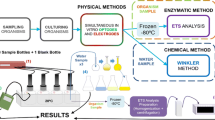Abstract
Electron transport system activity (ETS) andrespiratory rate (R) were measured in five Daphnia species at different temperatures in thelaboratory. The animals were collected from differenthabitats: Daphnia hyalina Leydig from aneutrophic subalpine lake, D. pulicariaForbes from an oligotrophic high-mountainlake, D. pulex Leydig from a temporary lowlandpool, and D. obtusa Kurz from a temporaryhighland pool. D. magna Straus was obtained fromlaboratory cultures.ETS activities and respiratory rates were studied injuveniles and adult females without eggs. The rateswere measured at 5, 10, 15, and 20 °C. Foradult females Q10 of ETS-activity ranged from 1.9for D. pulicaria to 2.2 for D. obtusa. Thevalues for juvenile individuals showed greatervariations, ranging from 1.6 for D. pulicaria to3.4 for D. hyalina. Q10 values forrespiration were from 1.3 to 1.7 for adults, and from1.4 to 2.1 for juveniles. The accelerating effect oftemperature (µ) ranged from 18.5 to 93.4 kJ mol-1.Average ETS/R ratios for single species for two lifestages ranged from 1.0 to 2.5.
Similar content being viewed by others
References
Armitage, K. B. & C. Lei, 1979. Temperature acclimatization in the filtering rates and oxygen consumption of Daphnia ambigua Scourfield. Comp. Biochem. Physiol. 62A: 807–813.
Bamstedt, U., 1980. ETS activity as an estimator of respiratory rate of zooplankton populations. The significance of variations in environmental factors. J. exp. mar. Biol. Ecol. 42: 267–283.
Bamstedt, U., 1988. Ecological significance of individual variability in copepod bioenergetics. Hydrobiologia 167/168: 43–59.
Blenkinsopp, S. A., P. A. Gabbott, C. Freeman & M. A. Lock, 1991. Seasonal trends in river biofilm storage products and electron transport system activity. Freshwat. Biol. 26: 21–34.
Borgmann, U., 1977. Electron transport system activity in Daphnia and crayfish. Can. J. Zool. 55: 847–854.
Borgmann, U., 1978. The effect of temperature and body size on electron transport system activity in freshwater zooplankton. Can. J. Zool. 56: 634–642.
Brancelj, A. & A. Blejec, 1994. Diurnal vertical migration of D. hyalinaLeydig, 1860 (Crustacea: Cladocera) in Lake Bled (Slovenia) in relation to temperature and predation. Hydrobiologia 284: 125–136.
Cammen, L. M., S. Corwin & J. P. Christensen, 1990. Electron transport system (ETS) activity as a measure of benthic macrofaunal metabolism. Mar. Ecol. Prog. Ser. 65: 171–182.
Giorgio, P. A., 1992. The relationship between ETS (electron transport system) activity and oxygen consumption in lake plankton: a cross-system calibration. J. Plankton Res. 14: 1723–1741.
Glazier, D. S., 1991. Separating the respiration rates of embryos and brooding females of Daphnia magna: Implications for the cost of brooding and allometry of metabolic rate. Limnol. Oceanogr. 36: 354–362.
Goss, L. B. & D. L. Bunting, 1980. Temperature effects on zooplankton respiration. Comp. Biochem. Physiol. 66A: 651–658.
G.-Tóth, L., 1993. Measurement of the terminal electron system (ETS)-activity of plankton and sediment. Proceedings of the ILEC/UNEP International Training Course, 149–152.
G.-Tóth, L., Zs. Langó, J. Padisák & E. Varga, 1994. Terminal electron transport system (ETS)-activity in the sediment of Lake Balaton, Hungary. Hydrobiologia 281: 129–139.
G.-Tóth, L., M. Szabo & D. Webb, 1995. Adaptation of the tetrazolium reduction test for the measurement of the electron transport system (ETS) activity during embryonic development of medaka. J. Fish. Biol. 46: 835–844.
Hrbáček, J., 1987. Systematics and biogeography of Daphniaspecies in the Northern temperate region. In Peters, R. H. & R. Bernardi (eds), ‘Daphnia’, Mem. Ist. ital. Idrobiol. 45: 37–76.
James, M. R., 1987. Respiratory rates in cladoceran Ceriodaphnia dubiain lake Rotiongaio, a monomictic lake. J. Plankton Res. 9: 573–578.
Kenner, R. A. & S. I. Ahmed, 1975a. Measurements of electron transport activities in marine phytoplankton. Mar. Biol. 33: 119–127.
Kenner, R. A. & S. I. Ahmed, 1975b. Correlation between oxygen utilization and electron transport activity in marine phytoplankton. Mar. Biol. 33: 129–133.
Lampert, W., 1984. The measurement of respiration. In Downing, J. A. & F. H. Rigler. A Manual on Methods for the Assessment of Secondary Productivity in Fresh Water. IPB Handbook 17, 2nd edn., Blackwell Sci. Publ. 413–468.
Martinez, R., 1992. Respiration and respiratory electron transport activity in marine phytoplankton: growth rate dependence and light enhancement. J. Plankon Res. 14: 789–797.
Owens, T. G. & F. D. King, 1975, The measurement of respiratory electron transport system activity in marine zooplankton. Mar. Biol. 30: 27–36.
Packard, T. T., 1971. The measurement of respiratory electron-transport activity in marine phytoplankton. J. mar. Res. 29: 235–244.
Packard, T. T., A. H. Devol & F. D. King, 1975. The effect of temperature on the respiratory electron transport system inmarine plankton. Deep-Sea Res. 22: 237–249.
Peters, R. H., 1987. Metabolism in Daphnia. In Peters, R. h. & R. de Bernardi (eds) ‘Daphnia’. Mem. Ist. ital. Idrobiol. 45: 193–243.
Rice,. R., 1989. Analyzing tables of statistical tests. Evolution 43: 223–225.
Robinson, C. & P. J. B. Williams, 1993. Temperature and antarctic plankton community respiration. J. Plankton Res. 15: 1035–1051.
Schmidt-Nielsen, I., 1979. Animal Physiology: Adaptation and Environment. 2nd edn. Cambridge University Press, 560 pp.
Urabe, J. & Y. Watanabe, 1990. Influence of food density on respiration rate of two crustacean plankters, Daphnia galeataand Bosmina longirostris.Oecologia 82: 362–368.
Vollenweider, R. A. & O. Ravera, 1958. Preliminary observations on the oxygen uptake by some freshwater zooplankters. Verh. int. Ver. Limnol. 12: 369–380.
Vosjan, J. H. & K. M. Olanczuk-Neyman, 1991. Influence of temperature on respiratory ETS-activity of micro-organisms from Admiralty Bay, King George Island, Antarctica. Neth. J. Sea Res. 28: 221–225.
Withers, P. C., 1992. Comparative Animal Physiology. Saunders Collage Publishing: 82–187.
Author information
Authors and Affiliations
Rights and permissions
About this article
Cite this article
Simčič, T., Brancelj, A. Electron transport system (ETS) activity and respiration rate in five Daphnia species at different temperatures. Hydrobiologia 360, 117–125 (1997). https://doi.org/10.1023/A:1003117221455
Issue Date:
DOI: https://doi.org/10.1023/A:1003117221455




